Bee balm also known by its botanical name of Monarda is a perennial flowering herb in the mint family. It consists of square stem, slender, serrated oppositely arranged leaves and creeping rhizomes that spread rapidly under the soil. The flowers are tubular and bilaterally symmetric with a narrow upper lip and a wider lower lip. The flowers are typically head-like clusters of flowers with leafy bracts.
Bee balm plant generally prefers moist, rich soil and a sunny location. It can tolerate shade, particularly in hot-summer areas. Most varieties of the bee balm plant are between 2 to 4 feet tall but there are also dwarf varieties less than 10 inches high. Bee balm is also attractive to bees, butterflies and hummingbirds. It is also a natural source of the antiseptic compound thymol, the primary active ingredients in some modern commercial mouthwash formulas.
1. Monarda Barletti
Monarda Barletti blooms consists of asymmetrical, two-lipped tubular flowers borne in dense, globular terminal heads, which rest upon a whorl of decorative bracts. They bloom for up to 6 weeks, usually from mid-summer to early fall. Its distinctive, brightly colored flower-heads create captivating border displays and provide a great impact when used in mass plantings.
Monarda combines very well with other summer perennials such as phlox, irises, daylilies and yarrows. Monarda blooms attract streams of butterflies, hummingbirds and other beneficial pollinators but they are deer and rabbit resistant.

Plant Profile
- Plant Type: Perennials
- Plant Family: Monarda Bee Balms
- Sunlight Requirement: Full Sun, Partial Sun
- Bloom Time: Summer to Early Fall
- Height: 2-3 feet
- Water Requirement: Average
- Maintenance: Average
- Soil Type: Chalk, Clay, Loam, Sand
- Soil PH: Acid, Alkaline, Neutral
- Hardiness Zones: 4-9
- Soil drainage: Moist But well Drained
- Attracts: Birds, Butterflies, Hummingbirds
- Garden Styles: Informal and cottage, Prairie and meadow
- Tolerance: Clay soil, Deer, Rabbit
2. Eastern Bee Balm (Monarda bradburiana)
Eastern Bee balm is a compact, clump-forming perennial boasting showy soft pinkish-lavender tubular flowers speckled with purple, held in dense globular terminal heads. It is best suited to perennial boarders, wild gardens, prairies and meadows. Eastern bee balm grows well in full sun or partial shade in dry to medium moisture, well-drained soil. It also tolerates poor soils.
Eastern bee balm blooms for at least 4 weeks in late spring and attracts a stream of butterflies and hummingbirds and other beneficial pollinators to the garden. This bee balm variety is resistant to powdery mildew, deer and rabbit.

Plant Profile
- Plant Type: Perennials
- Plant Family: Monarda Bee Balms
- Sunlight Requirement: Full Sun, Partial Sun
- Bloom Time: Summer to Early Fall
- Height: 2-3 feet
- Water Requirement: Average
- Maintenance: Average
- Soil Type: Chalk, Clay, Loam, Sand
- Soil PH: Acid, Alkaline, Neutral
- Hardiness Zones: 4-9
- Soil drainage: Moist But well Drained
- Attracts: Birds, Butterflies, Hummingbirds
- Garden Styles: Informal and cottage, Prairie and meadow
- Tolerance: Clay soil, Deer, Rabbit
Also Read: Different Types of Anthurium
3. Lemon Bee Balm (Monarda citriodora)
Lemon bee balm also referred to as lemon mint or purple horsemint grows to about 30 inches and produce tight, spike-shaped clusters of lavender flowers. Its purple flowers are highly attractive to butterflies, bees and hummingbirds. Horsemint has a distinctive citrus or lemony scent when the leaves are rubbed or crushed. It grows quickly during spring, reaching up to 3 feet high and blooms from May through July.
Lemon bee balm is easy to grow and often forms large colonies, it tolerates poor and rocky soils and actually prefers soil that is sandy or with limestone and requires little water and direct sunlight. This widespread plant grows in prairies, roadsides and other sunny habitats from Arizona to Florida.
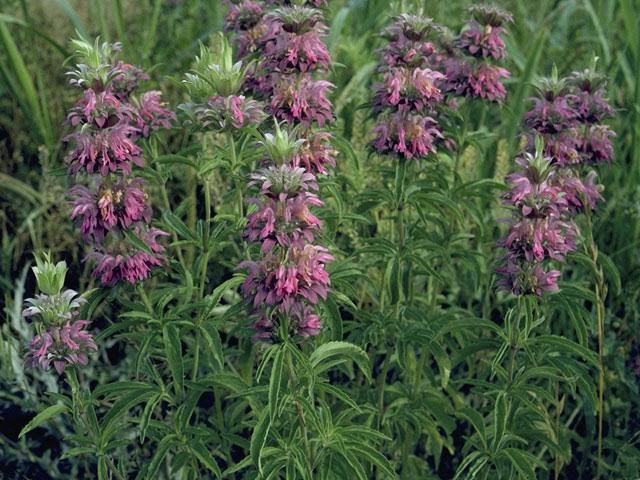
Plant Profile
- Plant Type: Perennials
- Plant Family: Monarda Bee Balms
- Sunlight Requirement: Full Sun, Partial Sun
- Bloom Time: Summer to Early Fall
- Height: 2-3 feet
- Water Requirement: Average
- Maintenance: Average
- Soil Type: Chalk, Clay, Loam, Sand
- Soil PH: Acid, Alkaline, Neutral
- Hardiness Zones: 4-9
- Soil drainage: Moist But well Drained
- Attracts: Birds, Butterflies, Hummingbirds
- Garden Styles: Informal and cottage, Prairie and meadow
- Tolerance: Clay soil, Deer, Rabbit
4. Basil Bee Balm (Monarda Clinopdia)
Basil Bee Balm also referred to as white bergamot grow up to 12 inches in height. The leaves are lanceolate to oblong, tapering at both ends with small hairs and small teeth. Flowers are born in small glomerules (clumps) of pink or purple flowers and green bracts, born in the axils of the upper leaves.

Plant Profile
- Plant Type: Perennials
- Plant Family: Monarda Bee Balms
- Sunlight Requirement: Full Sun, Partial Sun
- Bloom Time: Summer to Early Fall
- Height: 2-3 feet
- Water Requirement: Average
- Maintenance: Average
- Soil Type: Chalk, Clay, Loam, Sand
- Soil PH: Acid, Alkaline, Neutral
- Hardiness Zones: 4-9
- Soil drainage: Moist But well Drained
- Attracts: Birds, Butterflies, Hummingbirds
- Garden Styles: Informal and cottage, Prairie and meadow
- Tolerance: Clay soil, Deer, Rabbit
5. Scarlet Bee Balm (Monarda Didyma)
Scarlet bee balm also referred to as the crimson beebalm, scarlet monarda or Oswego tea grows to 0.7-1.5 m in height, with the stems square in cross-section. The leaves are opposite on the square stems and dark green with reddish leaf veins and a coarsely toothed margin. The plant has ragged, bright red tubular flowers borne on showy heads of about 30 together, with reddish bracts. It grows in dense clusters along stream banks, thickets and ditches, flowering from mid-summer to late summer.

Plant Profile
- Plant Type: Perennials
- Plant Family: Monarda Bee Balms
- Sunlight Requirement: Full Sun, Partial Sun
- Bloom Time: Summer to Early Fall
- Height: 2-3 feet
- Water Requirement: Average
- Maintenance: Average
- Soil Type: Chalk, Clay, Loam, Sand
- Soil PH: Acid, Alkaline, Neutral
- Hardiness Zones: 4-9
- Soil drainage: Moist But well Drained
- Attracts: Birds, Butterflies, Hummingbirds
- Garden Styles: Informal and cottage, Prairie and meadow
- Tolerance: Clay soil, Deer, Rabbit
6. Spotted Bee Balm (Monarda Punctata)
Spotted Bee Balm is clump-forming, short lived perennial or biennial, boasting showy clusters of creamy purple-spotted tubular flowers resting upon pink, lavender or creamy bracts. Spotted bee balm blooms for at least 4 weeks from early to mid summer and it attracts scores of butterflies and pollinators to the garden.
This plant will grow in full to partial sun and very dry to average soil moisture. It occurs naturally in sandy areas such as dunes, fields and relic prairies and is often found in disturbed areas including along railroads and roadsides. Spotted bee balm is best suited to perennial borders, wild gardens, prairies and meadows.

Plant Profile
- Bloom Period: Late, Mid-summer
- Growth Cycle: Annual, Biannual, Perennial
- Growth Habit: Forbs/Herb, Shrub
- Light Requirement: Full, Partial sunlight
- Native: Eastern Canada, United States and Northeastern Mexico
- Soil Type: Well drained
7. Seaside Bee Balm (Monarda maritima)
The seaside bee balm is a much-endangered species of the Monarda native to the coastal plains of Texas. Seaside bee balm produces white blooms and blooms for at least 4 weeks in late spring and attracts a stream of butterflies and hummingbirds and other beneficial pollinators to the garden. The seaside bee balm variety is resistant to powdery mildew, deer and rabbit.
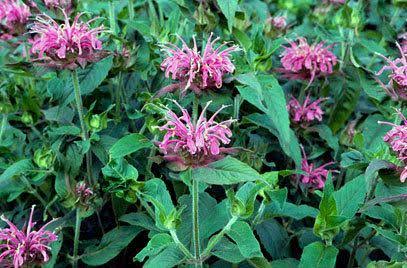
Plant Profile
- Plant Type: Perennials
- Plant Family: Monarda Bee Balms
- Sunlight Requirement: Full Sun, Partial Sun
- Bloom Time: Summer to Early Fall
- Height: 2-3 feet
- Water Requirement: Average
- Maintenance: Average
- Soil Type: Chalk, Clay, Loam, Sand
- Soil PH: Acid, Alkaline, Neutral
- Hardiness Zones: 4-9
- Soil drainage: Moist But well Drained
- Attracts: Birds, Butterflies, Hummingbirds
- Garden Styles: Informal and cottage, Prairie and meadow
- Tolerance: Clay soil, Deer, Rabbit
Also Read: Different Types of Monstera Varieties
8. Pony Bee Balm (Modarna Pectinata)
Pony bee balm is native to central and southwestern United States particularly great plains and Rocky Mountains. It prefers slightly acidic well drained soil. The flowers of this variety are in whorls that are very light lavender in color. The flowers are highly attractive to butterflies, bees and hummingbirds.

Plant Profile
- Growth Habit: Herb/Forb
- Life Cycle: Annual
- Light Requirement: Full sun to Partial Shade
- Leaves: Fragrant
- Flower Color: Blue or purple
- Propagation: Stem & root cuttings
9. Monarda Purple Lace
Purple lace bee balm consists of deep purple-red flowers, borne in dense, globular terminal heads. Blooming for weeks from mid-summer to early fall, they rest upon a whorl of decorative purple bracts. This variety grows well in full sun or partial shade in moderately fertile, humus, moist but well-drained soil.

Plant Profile
- Plant Type: Perennials
- Plant Family: Monarda Bee Balms
- Sunlight Requirement: Full Sun, Partial Sun
- Bloom Time: Summer to Early Fall
- Height: 2-3 feet
- Water Requirement: Average
- Maintenance: Average
- Soil Type: Chalk, Clay, Loam, Sand
- Soil PH: Acid, Alkaline, Neutral
- Hardiness Zones: 4-9
- Soil drainage: Moist But well Drained
- Attracts: Birds, Butterflies, Hummingbirds
- Garden Styles: Informal and cottage, Prairie and meadow
- Tolerance: Clay soil, Deer, Rabbit
10. Monarda Marshall’s Delight
Monarda Mashall’s delight is consists of masses of clear pink flowers, born in dense, globular terminal heads. It blooms for weeks from mid-summer to early fall. This variety of Monarda is typically resistant to powdery mildew. The boldness of its blooms makes it terrific for massing or as accent plant. Marshall’s delight performs best in full sun or partial shade in moderately fertile, humus-rich, moist but well-drained soil.
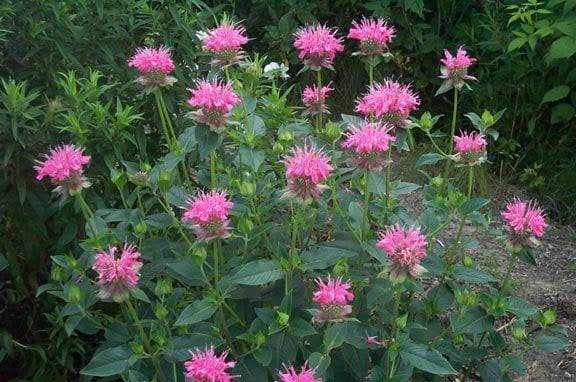
Plant Profile
- Plant Type: Perennials
- Plant Family: Monarda Bee Balms
- Sunlight Requirement: Full Sun, Partial Sun
- Bloom Time: Summer to Early Fall
- Height: 2-3 feet
- Water Requirement: Average
- Maintenance: Average
- Soil Type: Chalk, Clay, Loam, Sand
- Soil PH: Acid, Alkaline, Neutral
- Hardiness Zones: 4-9
- Soil drainage: Moist But well Drained
- Attracts: Birds, Butterflies, Hummingbirds
- Garden Styles: Informal and cottage, city and courtyard, Prairie and meadow
- Tolerance: Clay soil, Deer, Rabbit
11. Monarda Kardinal
Monarda ‘Kardinal’ Bee balm consist of masses of brilliant raspberry red flowers, borne in dense, globular terminal heads. It grows between 3 and 4 feet tall and performs best in full sun or partial shade in moderately fertile, humus-rich, moist but well-drained soil. This variety blooms for several weeks from mid-summer to early fall. The flowers attract streams of butterflies, hummingbirds and other pollinators. It is also resistant to powdery mildew.
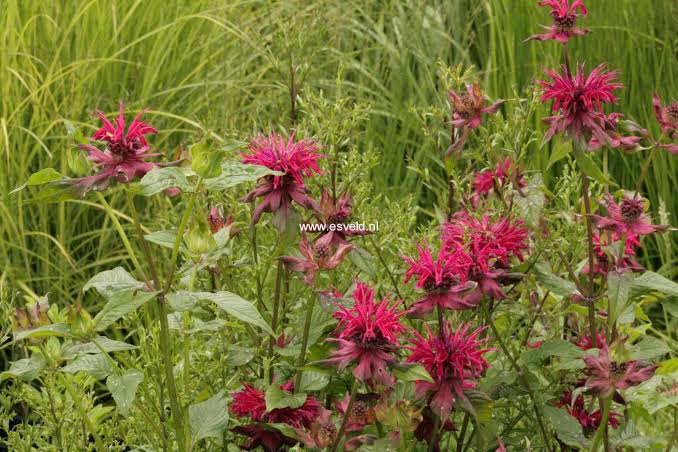
Plant Profile
- Plant Type: Perennials
- Plant Family: Monarda Bee Balms
- Sunlight Requirement: Full Sun, Partial Sun
- Bloom Time: Summer to Early Fall
- Height: 2-3 feet
- Water Requirement: Average
- Maintenance: Average
- Soil Type: Chalk, Clay, Loam, Sand
- Soil PH: Acid, Alkaline, Neutral
- Hardiness Zones: 4-9
- Soil drainage: Moist But well Drained
- Attracts: Birds, Butterflies, Hummingbirds
- Garden Styles: Informal and cottage, Prairie and meadow
- Tolerance: Clay soil, Deer, Rabbit
12. Monarda Vintage Wine
Monarda vintage wine bee balm consists of masses of dark, wine red flowers, borne in dense, globular terminal heads. It grows in clumps of upright stems, up to 3 feet tall and performs best in full sun or partial shade in moderately fertile, humus-rich, moist but well-drained soil. Flowers of this variety rest upon a whorl of decorative bracts and blooms for weeks from mid-summer to early fall. The blooms also attract butterflies and hummingbirds to the garden. This Monarda is typically resistant to powdery mildew.
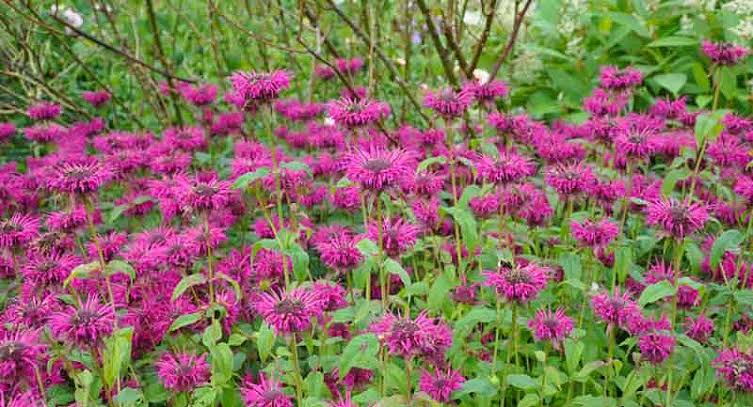
Plant Profile
- Plant Type: Perennials
- Plant Family: Monarda Bee Balms
- Sunlight Requirement: Full Sun, Partial Sun
- Bloom Time: Summer to Early Fall
- Height: 2-3 feet
- Water Requirement: Average
- Maintenance: Average
- Soil Type: Chalk, Clay, Loam, Sand
- Soil PH: Acid, Alkaline, Neutral
- Soil drainage: Moist But well Drained
- Attracts: Birds, Butterflies, Hummingbirds
- Garden Styles: Informal and cottage, Prairie and meadow